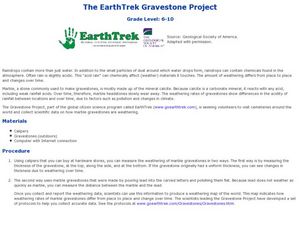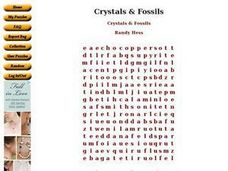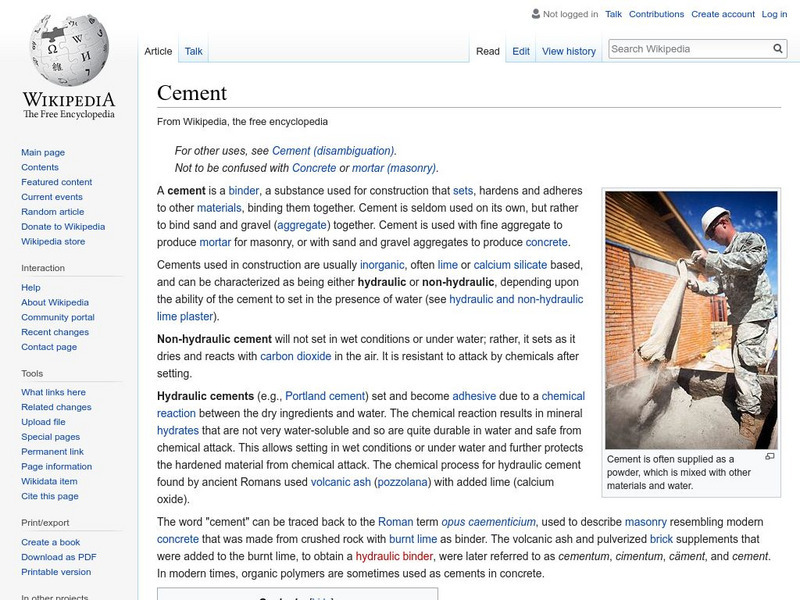Curated OER
EarthTrek Gravestone Project
Students explore the effects of acid rain. In this acid rain lesson, students investigate the effects of the weathering from acid rain in different places. Students visit cemetaries to collect data about the effects of acid rain on the...
Curated OER
Percent Deviation Rocks and Minerals
In this rocks and minerals worksheet, students calculate the percent deviation from various mass measurements taken of rocks or minerals. This worksheet has 10 problems to solve.
Curated OER
Caves Word Search
In this caves word search, students identify words related to formations found in caves. They locate 20 words from a given list. An answer sheet is provided.
Curated OER
Crystals & Fossils
In this earth science activity, students identify and locate vocabulary terms related to crystals and fossils. There are 32 words located in the puzzle.
Curated OER
Caverns: Types of speleothems
Pupils identify types of speleothems commonly found in limestone caverns. They perform various activities based on grade level.
Province of British Columbia
B.c. Ministry of Energy and Mines: Common Rock Forming Minerals
There are six common minerals most often found in rocks. They are quartz, feldspar, olivine, mica, pyroxene, and amphibole. This website provides photos and information on each, and discusses their importance when identifying rocks.
Other
Webmineral.com: Mineralogy Database: Calcite Mineral Data
This site by David Barthelmy gives exceptionally detailed information on the mineral calcite, with photos and clear terminology, crystallography data, Dana and Strunz classifications and much more.
Other
The image.com: Minerals
This is a very large list of minerals complete with image and physical descriptions, chemical descriptions, and classification.
University of California
Uc Davis Geo Wiki: Chemical Budgets of Oceanic Elements
To the extent that the composition of the ocean remains constant, the rate at which any one element is introduced into seawater must equal the rate of its removal. A listing of the various routes of addition and removal, together with...
Simon Fraser University
Chem1 Virtual Textbook: Chemical Budgets of Oceanic Elements
As part of the General Chemistry Virtual Textbook, this site examines a variety of topics related to the elements of the oceans. Topics covered include Phosphorus, Carbon, Bicarbonate, Calcite, and more.
Other
Clemson University: Soil Acidity and Liming
Covers the composition and uses of liming materials in agriculture, as well as the lime codes of several states. Good definitions of terms: lime, calcitic limestone, calcite, dolomite, dolomitic limestone, aragonite, hi-cal lime, and more.
CK-12 Foundation
Ck 12: Plix: Mineral Formation
[Free Registration/Login may be required to access all resource tools.] See mineral formation with this interactive animation! Also test your knowledge of mineral formation with a short assessment.
Amethyst Galleries
Amethyst Galleries: Mineral Gallery: The Mineral Calcite
The world's most common mineral, Calcite, has many uses and varieties. This website lists the physical characteristics of Calcite and includes color images.
Indiana University
Indiana University Bloomington: Reference Documents: Calcite [Pdf]
A fact card describing the characteristics of calcite and its presence in limestone, its chemical and physical properties, and the composition and structure of a calcite unit cell.
Utah State Office of Education
Utah State Office of Education: Identifying and Classifying Minerals
This thorough Utah State Office of Education site explains the criteria for identifying minerals and provides pictures of various minerals.
Other
The Happy Scientist: Minerals
Overview of minerals with definitions, how to identify them, what they are used for, and crystals.
Wikimedia
Wikipedia: Cement
Wikipedia provides this encyclopedia entry for cement that features its history, production, and use as a building material, as well as links to related topics.
Curated OER
The image.com: Minerals
This is a very large list of minerals complete with image and physical descriptions, chemical descriptions, and classification.















